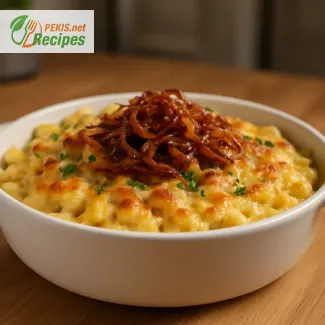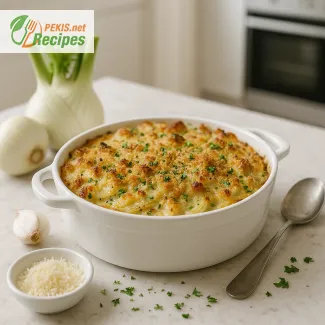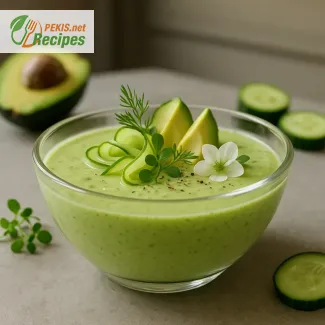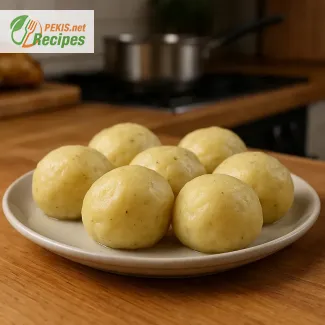
Discover the Timeless Delight of German Käsespätzle
Why Käsespätzle is the Ultimate Comfort Food from Germany
When it comes to traditional German cuisine, few dishes capture the heart and soul of comfort food quite like Käsespätzle. This beloved specialty, often referred to as German cheese spaetzle, brings together the satisfying chew of homemade noodles and the rich, creamy taste of melted cheese. Perfect for cozy family dinners, festive gatherings, or simply indulging in authentic Alpine flavors, Käsespätzle stands as a symbol of Swabian culinary tradition that has earned admiration far beyond the borders of Germany.
The dish is renowned for its simple yet flavorful combination of ingredients. Soft, egg-rich spaetzle noodles, layered generously with grated cheese—typically a mix of Emmental and Gruyère—create a creamy texture that melts in your mouth. Finished with golden, crispy caramelized onions, this dish offers a perfect balance of savory, creamy, and sweet notes that appeal to every palate. Whether enjoyed as a main course or a hearty side dish, Käsespätzle brings a sense of warmth and satisfaction with every bite.
The Rich Heritage Behind Käsespätzle
Rooted in the Swabian region of southern Germany, Käsespätzle has been passed down through generations as a cherished recipe that reflects the resourcefulness and hospitality of the region’s people. Traditionally prepared in homes and mountain lodges, the dish was designed to provide nourishment after long days of work in the fields or hikes in the Alps. Today, Käsespätzle is celebrated across Germany, Austria, and even parts of Switzerland, where it appears on menus of rustic taverns and fine-dining restaurants alike.
What makes Käsespätzle so universally loved is its adaptability. While the classic version features Emmental or Gruyère cheese, regional variations often incorporate other types of cheese or unique additions like crispy bacon, herbs, or even a hint of nutmeg. This flexibility allows home cooks to create a version of German cheese spaetzle that suits their personal taste and the preferences of their family and friends.
Key Elements That Make Käsespätzle Exceptional
Homemade Spaetzle Noodles
At the heart of Käsespätzle are the freshly made spaetzle noodles. Unlike standard pasta, these soft, irregularly shaped noodles are crafted from a simple dough of flour, eggs, and water. Their slightly chewy texture makes them ideal for soaking up the rich, cheesy sauce while retaining their structure. The process of making spaetzle is both rewarding and accessible, whether using a spaetzle maker or crafting them by hand.
The Perfect Cheese Blend
The choice of cheese is crucial to achieving the signature creaminess of Käsespätzle. A combination of Emmental and Gruyère delivers the ideal balance of flavor—mild and nutty from the Emmental, with deeper, more complex notes from the Gruyère. When melted between layers of hot noodles, the cheese forms luscious strands that bind the dish together and give it its characteristic richness.
Golden Caramelized Onions
No plate of Käsespätzle is complete without a generous topping of caramelized onions. Slowly cooked until golden brown and sweet, these onions add a depth of flavor that contrasts beautifully with the creamy cheese and tender noodles. The onions not only enhance the taste but also provide an inviting aroma that fills the kitchen as the dish is prepared.
A Dish for All Occasions
Käsespätzle is more than just a meal—it’s an experience that brings people together. Whether served as a main course at a casual dinner or as a side dish at a festive gathering, its rich flavors and satisfying texture make it a favorite for young and old alike. The dish pairs wonderfully with a crisp green salad or a glass of dry white wine, completing the dining experience with refreshing contrasts.
Many home cooks find joy in preparing Käsespätzle from scratch, not only for its delicious results but also for the connection it fosters to heritage and tradition. The act of making spaetzle by hand, layering the cheese, and watching the onions slowly caramelize evokes a sense of timelessness that modern convenience foods simply cannot match.
Regional Variations and Personal Touches
While the classic recipe remains a staple, Käsespätzle invites creativity. In the Allgäu region, for example, it’s common to use a sharper mountain cheese for a more pronounced flavor. Some cooks choose to sprinkle fresh herbs like chives or parsley on top, while others might include bits of crispy bacon for a smoky note. No matter the variation, the core appeal of Käsespätzle remains the same: it’s a dish that offers comfort, flavor, and tradition in every forkful.
For anyone seeking to explore authentic German cooking, mastering Käsespätzle is a rewarding place to start. Its combination of accessible ingredients, straightforward preparation, and outstanding taste ensures that this recipe will become a regular feature on the dinner table.
1. Prepare the spaetzle dough: In a large mixing bowl, combine the all-purpose flour and salt. Make a well in the center and add the eggs and whole milk. Stir vigorously with a wooden spoon or beat with a hand mixer until you achieve a smooth, slightly sticky dough. Let the dough rest for 10 minutes.
2. Cook the spaetzle: Bring a large pot of salted water to a boil. Using a spaetzle maker or colander with large holes, press the dough into the boiling water. When the spaetzle rise to the surface, cook for an additional 2-3 minutes, then remove with a slotted spoon and set aside.
3. Caramelize the onions: In a large frying pan, heat the vegetable oil and butter over medium heat. Add the sliced yellow onions and cook slowly, stirring occasionally, until golden brown and caramelized, about 15-20 minutes.
4. Assemble the dish: Preheat the oven to 180°C (350°F). In a greased baking dish, layer the cooked spaetzle, Emmental cheese, and Gruyère cheese, seasoning each layer with black pepper and a touch of nutmeg. Finish with the caramelized onions on top.
5. Bake: Bake in the preheated oven for 10-12 minutes, or until the cheese is fully melted and bubbling.
6. Serve: Sprinkle with freshly chopped parsley before serving. Enjoy hot.
Creative Ways to Elevate Your Käsespätzle at Home
Enhance the Flavor and Texture of Your German Cheese Spaetzle
While the traditional Käsespätzle recipe delivers a wonderfully satisfying and creamy comfort dish, there are many ways to take this classic German favorite to a new level. Whether you want to intensify its flavor, introduce healthier alternatives, or simply put a personal spin on the dish, small changes can have a significant impact on the final result. In this guide, we will explore proven tips to help you improve your Käsespätzle, avoid common mistakes, and create a meal that is both authentic and uniquely your own.
Choosing the Right Cheese for Maximum Creaminess
The type of cheese you use can dramatically influence the taste and texture of your Käsespätzle. While the classic combination of Emmental and Gruyère provides a perfect balance of nutty and creamy flavors, experimenting with other varieties can add depth. Try using a sharper mountain cheese or a touch of smoked cheese for added complexity. For an even silkier texture, include a small amount of cream cheese or Mascarpone, which melts smoothly and enriches the sauce without overpowering it.
Improving the Spaetzle Dough for Better Texture
The foundation of Käsespätzle lies in its noodles. To make spaetzle that is lighter and more tender, consider adding a tablespoon of olive oil to your dough mixture. This helps keep the noodles moist and prevents them from sticking together. Another secret is to let the dough rest a little longer—about 20 to 30 minutes—before cooking. This resting period allows the flour to fully absorb the liquids, resulting in a smoother texture once boiled.
Enhancing the Onion Topping
The caramelized onions are essential for that sweet, golden topping that contrasts so well with the richness of the cheese. To elevate their flavor, cook them low and slow, and consider adding a splash of balsamic vinegar or a teaspoon of brown sugar toward the end of cooking. This creates a deeper, almost jam-like sweetness that beautifully complements the savory layers beneath.
Healthier Ingredient Swaps for a Lighter Dish
If you want to enjoy Käsespätzle with less guilt, there are several healthier alternatives you can try without sacrificing taste. Swap some or all of the all-purpose flour with whole wheat flour or a gluten-free blend for added fiber or to suit dietary needs. Instead of using large amounts of butter, use a mix of olive oil and a small pat of butter for flavor with less saturated fat. You can also reduce the quantity of cheese slightly and enhance the flavor with fresh herbs like parsley, chives, or thyme for a fresher, brighter taste.
Adding Extra Layers of Flavor
Beyond the basic recipe, there are many ways to give Käsespätzle more personality. Adding crisped bacon or speck between the layers introduces a smoky note that pairs well with the creamy cheese. A sprinkle of freshly grated nutmeg on each layer adds a warm, aromatic touch. You can also try layering in sautéed wild mushrooms for an earthy, umami-rich dimension that makes the dish more complex and satisfying.
Why Homemade Käsespätzle Always Tastes Better
When you prepare Käsespätzle at home, you have control over the quality of ingredients, which is one of the biggest reasons it tastes superior to store-bought or restaurant versions. Using freshly grated cheese rather than pre-shredded varieties ensures better melting and flavor. Freshly made spaetzle noodles offer a delicate texture that no packaged option can match. Moreover, the time and care invested in caramelizing onions to perfection add that final touch that makes a homemade dish truly special.
Common Pitfalls to Avoid
One frequent mistake when making Käsespätzle is using cheese that doesn’t melt well, leading to clumps rather than a smooth, creamy layer. Always opt for cheeses known for their excellent melting properties. Another error is overcooking the spaetzle, which can result in mushy noodles that don’t hold up well under the weight of the cheese and onions. Be sure to remove the noodles as soon as they float and are tender. Additionally, avoid assembling the dish too far in advance without baking it, as this can make the spaetzle soggy from sitting in the moisture of the cheese and onions.
Small Touches That Make a Big Difference
Even simple adjustments can make your Käsespätzle stand out. For example, rubbing the baking dish with a clove of garlic before layering the ingredients infuses a subtle depth of flavor. Toasting a handful of breadcrumbs in a bit of butter and sprinkling them over the top before baking gives the dish a delightful crunch that contrasts with the soft noodles and gooey cheese.
Presentation and Serving Suggestions
Serving Käsespätzle hot from the oven in individual baking dishes or a large, rustic casserole dish makes for a beautiful presentation. Garnish with a generous amount of fresh parsley or chives just before bringing it to the table. For a well-rounded meal, pair it with a crisp green salad dressed with a light vinaigrette or some steamed vegetables to balance the richness of the main dish.
Customizing Your Käsespätzle
Creating a version of Käsespätzle that reflects your taste preferences while respecting its traditional roots is part of what makes this dish so rewarding to prepare. From cheese choices to added ingredients and healthier swaps, every decision you make contributes to a unique and delicious result that will delight both you and your guests. The key is to start with a solid foundation and let your creativity guide you as you experiment with new flavors and textures.
Allergens present in the recipe:
- Gluten (from all-purpose flour)
- Eggs
- Milk / Dairy (cheese, milk, butter)
Tips for replacing allergens and gluten:
- Replace all-purpose flour with a gluten-free flour blend suitable for pasta making.
- Use plant-based milk (e.g., almond milk) and vegan cheese alternatives to avoid dairy allergens.
- Substitute egg replacer or flaxseed meal mixed with water for the eggs.
Vitamins and minerals per serving (approximate):
- Calcium 480 mg – supports bone health and muscle function
- Iron 3.2 mg – important for oxygen transport in blood
- Vitamin A 420 µg – essential for vision and immune health
- Vitamin D 1.5 µg – helps in calcium absorption
- Potassium 350 mg – supports heart and muscle function
- Magnesium 40 mg – aids in nerve and muscle function
Antioxidants per serving (approximate):
- Lutein + zeaxanthin 150 µg – contributes to eye health
- Beta-carotene 500 µg – precursor to vitamin A, supports immune system
- Quercetin 8 mg – helps reduce inflammation and oxidative stress





